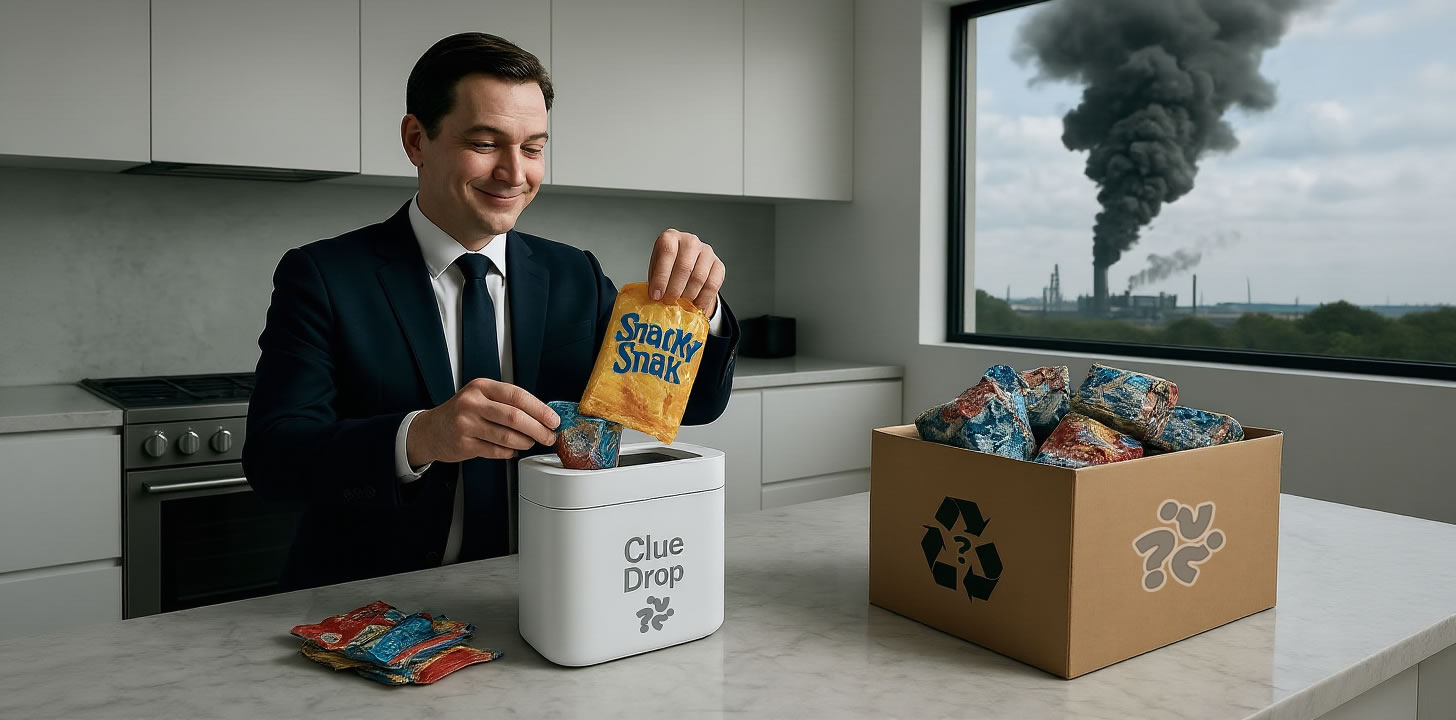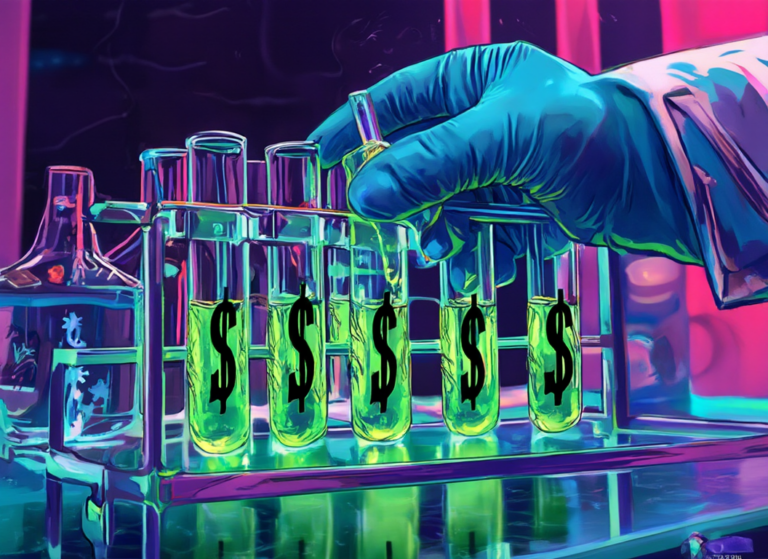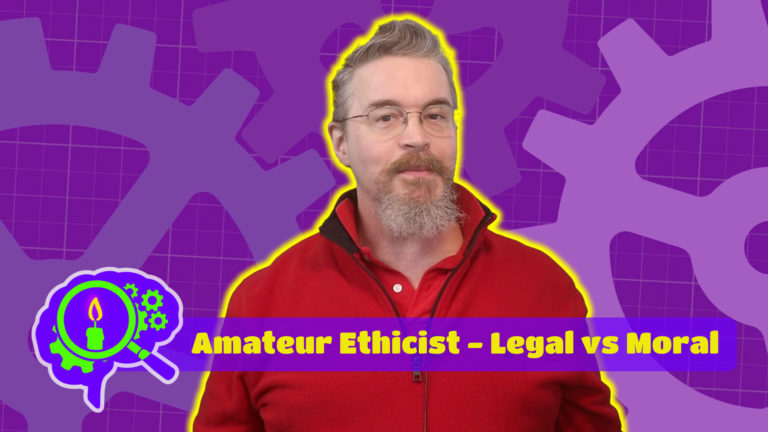The Compacted Truth: How Clear Drop Sells Absolution, Not Solutions
On the kitchen counter, between the stainless steel coffee maker and the artisan toaster, sits the latest must-have appliance for the conscious consumer. Its sleek, white plastic casing promises a modern solution to an ancient problem: guilt. This is the Clear Drop SPC, a device that compacts the endless flow of soft plastic wrappers, pouches, and films into neat, tidy bricks. For a $50 monthly subscription fee, the company whisks these bricks away by mail, offering “real recycling” and a clear conscience.
It’s a compelling fantasy. The advertisement doesn’t show the landfill or the toxic emissions. It shows a clean hand placing a compacted block into a branded cardboard box, a smile of relief. The mess is gone. The guilt, assuaged.
But this product represents something far more insidious than a simple kitchen gadget—it’s a masterclass in greenwashing that preys on environmental anxiety while perpetuating the very systems it claims to solve.
The Privilege of “Solutions”
At $50 per month ($600 annually) plus the initial device cost, Clear Drop is a luxury item for the affluent. It creates a two-tiered system where those with means can purchase a clear conscience while the structural problem remains unaddressed for everyone else. True environmental solutions must be accessible, equitable, and systemic—not individualistic and expensive. This device competes for precious counter space with other high-end appliances, targeting consumers who already have the privilege of choice but may lack the systemic perspective to see through the marketing.
Perpetuating the Problem, Not Solving It
The most insidious aspect of Clear Drop is that it’s designed to manage waste, not prevent it. By making it slightly less inconvenient to handle soft plastic waste, it implicitly encourages continued consumption of single-use plastics. The device requires a steady stream of new plastic to justify its existence, making consumers complicit in perpetuating the very system they hope to escape.
This machine isn’t just processing plastic; it’s processing a narrative. It tells us that the problem isn’t the relentless production of single-use plastic packaging—the problem is that we aren’t managing it correctly. It treats the symptom (the pile of plastic) while completely ignoring the disease (the unnecessary production of disposable packaging).
The Black Box of “Real Recycling”
Here’s where Clear Drop’s marketing becomes particularly deceptive. The company’s website offers hopeful yet tellingly vague promises. They claim bricks are “transformed into new products” like lumber and decking to “close the loop.” This language evokes a circular economy but carefully avoids naming any specific recycling partners or detailing the actual mechanical or chemical processes involved. This lack of transparency is the first and most glaring red flag.
Follow that branded box on its journey, and the fantasy meets a grittier reality. Without named partners or specified processes, the most likely destinations for these compacted bricks are:
Downcycling (Most Likely Scenario): The company’s suggested outcome—”plastic lumber”—points squarely to downcycling, not recycling. Mixed plastic films are melted into low-value, single-use products like park benches or railroad ties. These products are often more fragile, susceptible to weathering, and—most importantly—are themselves unrecyclable, merely delaying a one-way trip to the landfill. The melting process itself releases harmful volatile organic compounds (VOCs) into the air.
Chemical “Recycling” (The Greenwashed Alternative): The other likely destination is the controversial practice euphemistically called “advanced recycling,” where plastic is subjected to intense heat and pressure through pyrolysis or gasification. This energy-intensive process typically converts plastic into low-quality fuel to be burned, releasing CO2 and toxic chemicals. Ironically, more energy could be saved by simply reducing plastic use in the first place than can ever be recovered from these wasteful processes. As the thread author correctly noted, these facilities are notorious for producing concentrated toxic waste, consuming massive amounts of energy, and being economically unsustainable without heavy subsidies. The company’s marketing makes no mention of these toxic emissions, energy consumption, or hazardous byproducts.
The Critical Truth: Neither outcome “closes the loop.” Both are linear processes that either delay or accelerate the plastic’s journey to environmental contamination.
The Business Model of Perpetual Guilt
The most revealing detail isn’t in the machine’s mechanism, but in its business model. This isn’t a one-time purchase of a compost bin that aligns with circular principles—it’s a perpetual subscription to a linear system. The solution isn’t sold; it’s leased. For a continuous monthly fee, the guilt is continuously hauled away, creating a monthly toll to keep the waste stream flowing.
This subscription model depends entirely on the continued production of soft plastic waste. The company has a vested interest in consumers never reducing their plastic consumption because that would threaten their recurring revenue. Clear Drop’s profitability is directly tied to the perpetuation of the waste problem it claims to solve. It’s a business model fundamentally at odds with actual environmental progress.
Violating the Zero Waste Hierarchy
The Zero Waste International Alliance hierarchy provides a clear framework for proper resource management:
- Rethink/Redesign – Systemic change to avoid needless consumption
- Reduce – Use less material and less toxic material
- Reuse – Retain the value, usefulness and function of products
- Recycle/Compost – Mechanical or biological processing as a last resort
- Material Recovery – Salvaging materials from mixed waste
- Residuals Management – Handling what’s left without threatening health
- Unacceptable – Systems that encourage wasting or threaten environmental health
Clear Drop completely bypasses the first three levels—the most critical and effective strategies. Instead of helping consumers rethink their consumption, reduce their plastic use, or reuse what they have, it jumps straight to questionable “recycling” that likely ends up in categories 5, 6, or even 7. It invests money and hope in the least effective options while the most important steps—prevention and reduction—remain unaddressed.
Worse still, Clear Drop’s likely processes (chemical recycling to fuel, incineration) fall into the “Unacceptable” category that environmental experts explicitly warn against. The hierarchy exists precisely to prevent solutions like this that sound good but ultimately perpetuate harm.
The Unverifiable Promise
Ultimately, the Clear Drop system operates as a black box. Consumers pay a premium to have their guilt whisked away in a branded box to an unnamed facility for an unspecified process. There is no verifiable chain of custody, no transparency about partners, and no honest accounting of environmental impact. Shipping waste to unknown facilities with unknown environmental standards is the antithesis of responsible waste management. In the absence of transparency, the optimistic claims on their website ring hollow.
True environmental solutions are built on data, verification, and honesty—not on feel-good marketing that obscures a product’s likely toxic and linear end-of-life. When a company cannot or will not tell you exactly what happens to your waste, that silence speaks volumes.
The Illusion of Individual Action
Clear Drop sells absolution wrapped in the aesthetic of sustainability. It preys on the genuine anxiety people feel about the waste they generate and offers a convenient, high-tech solution that requires no real change in behavior. The compacted blocks and clean counters are an illusion of action, built on a business model that depends on secrecy and the continued production of the plastic waste it claims to solve.
This device allows consumers to feel good about their environmental impact without confronting the need to consume less or demand better from manufacturers. It provides social license for producers to continue making disposable products while shifting responsibility—and cost—to individual consumers.
What Real Solutions Look Like
Instead of a $50-per-month brick-making subscription, we need:
Policy Changes: Strong extended producer responsibility (EPR) laws that make brands financially responsible for the end-of-life of their packaging, incentivizing them to design reusable systems from the start.
Infrastructure Investment: Support for refillable container systems, like Loop programs at grocery stores, that eliminate single-use packaging entirely.
Local Solutions: Investment in regional reuse and repair systems that keep materials in the community rather than shipping waste across the country, reducing transportation emissions while improving accountability.
Cultural Shifts: Normalizing the refusal of unnecessary plastic packaging and supporting businesses that prioritize reusable alternatives.
Transparency: Honest conversations about the failures of plastic recycling and the true environmental cost of our disposable culture.
The Bottom Line
The problem isn’t that Clear Drop perpetuates waste—it’s that it sells a lie wrapped in environmental virtue signaling. This device doesn’t solve the plastic crisis; it monetizes guilt while keeping the fundamental system intact. For $600 a year, consumers can maintain their consumption patterns while feeling environmentally responsible, all while their compacted waste likely ends up burned, downcycled, or generating toxic byproducts somewhere out of sight.
True relief won’t come from a smaller pile of trash or a cleaner counter. It will come from building systems that don’t create unnecessary waste in the first place, demanding transparency from companies that handle our waste, and refusing to let guilt be packaged and sold back to us as a subscription service.
The blocks are compacted. The counter is clean. But the problem hasn’t been solved—it’s just been condensed, boxed, and mailed to someone else’s backyard, out of sight and out of mind./isolated-segment.html







